Reflective Approaches in Implementing Person-Centred Approach Report
VerifiedAdded on 2023/01/19
|10
|2626
|23
Report
AI Summary
This report focuses on reflective approaches in implementing person-centred care, presenting two training booklets designed for new healthcare professionals. Booklet 1 explores a holistic approach to person-centred practice, emphasizing empowerment, rights, trust, and communication. It contrasts the medical and social models of disability through a case study of a wheelchair-bound teenager, highlighting how the social model promotes patient needs and wants. The booklet also discusses duty of care, challenges in providing person-centred care, and the importance of considering patient viewpoints. Booklet 2 examines current policies, legislation, and regulations, including the Care Quality Commission's Safe Care and Treatment regulation and the Data Protection Act 1998. It addresses challenges such as miscommunication and poor team working in relation to policies like the Patient and Public Participation Policy and Equality and Diversity. The report concludes by emphasizing the essential role of person-centred care in treatment effectiveness and the need for continuous improvement in staff training and communication strategies to meet legislative requirements and overcome barriers.
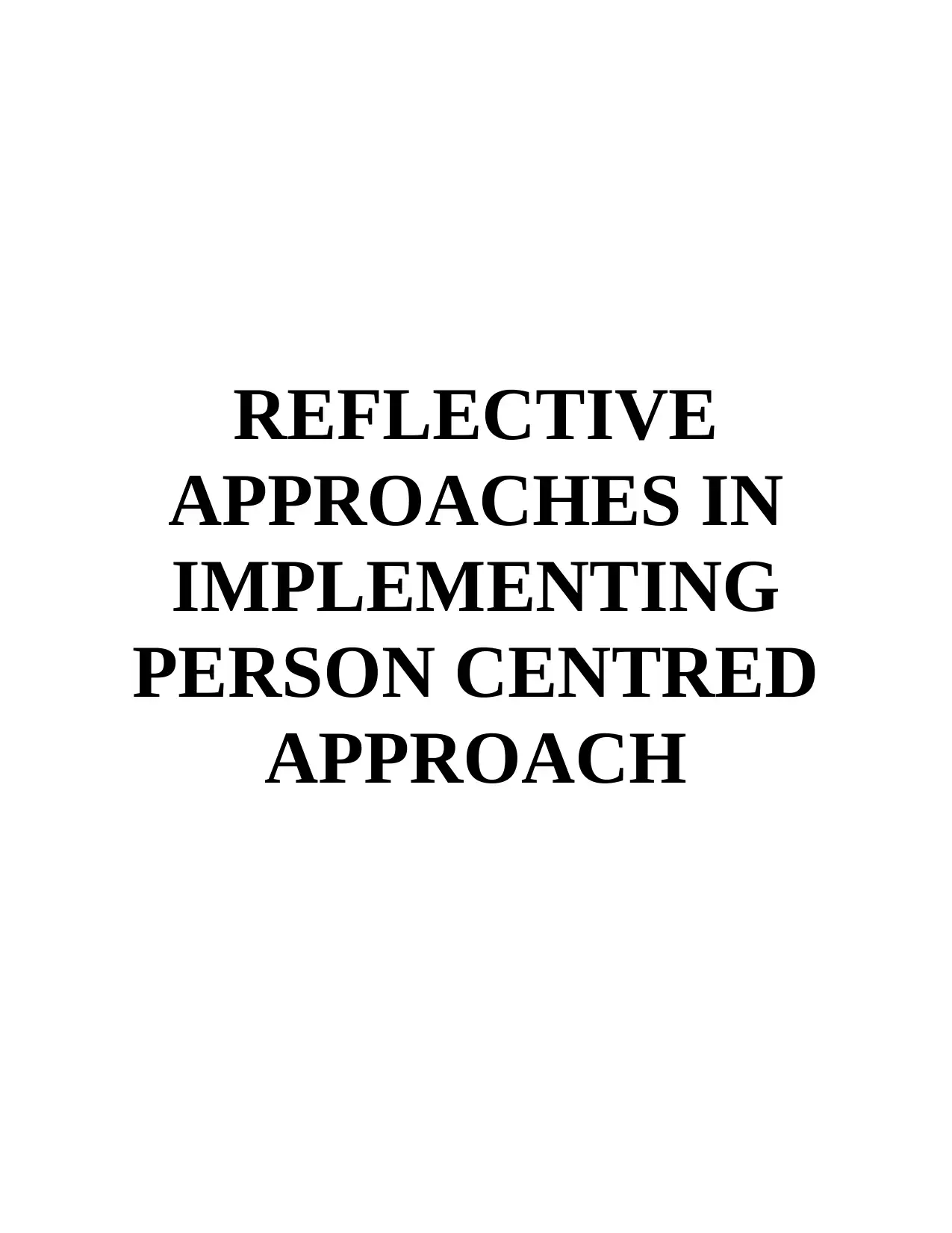
REFLECTIVE
APPROACHES IN
IMPLEMENTING
PERSON CENTRED
APPROACH
APPROACHES IN
IMPLEMENTING
PERSON CENTRED
APPROACH
Paraphrase This Document
Need a fresh take? Get an instant paraphrase of this document with our AI Paraphraser
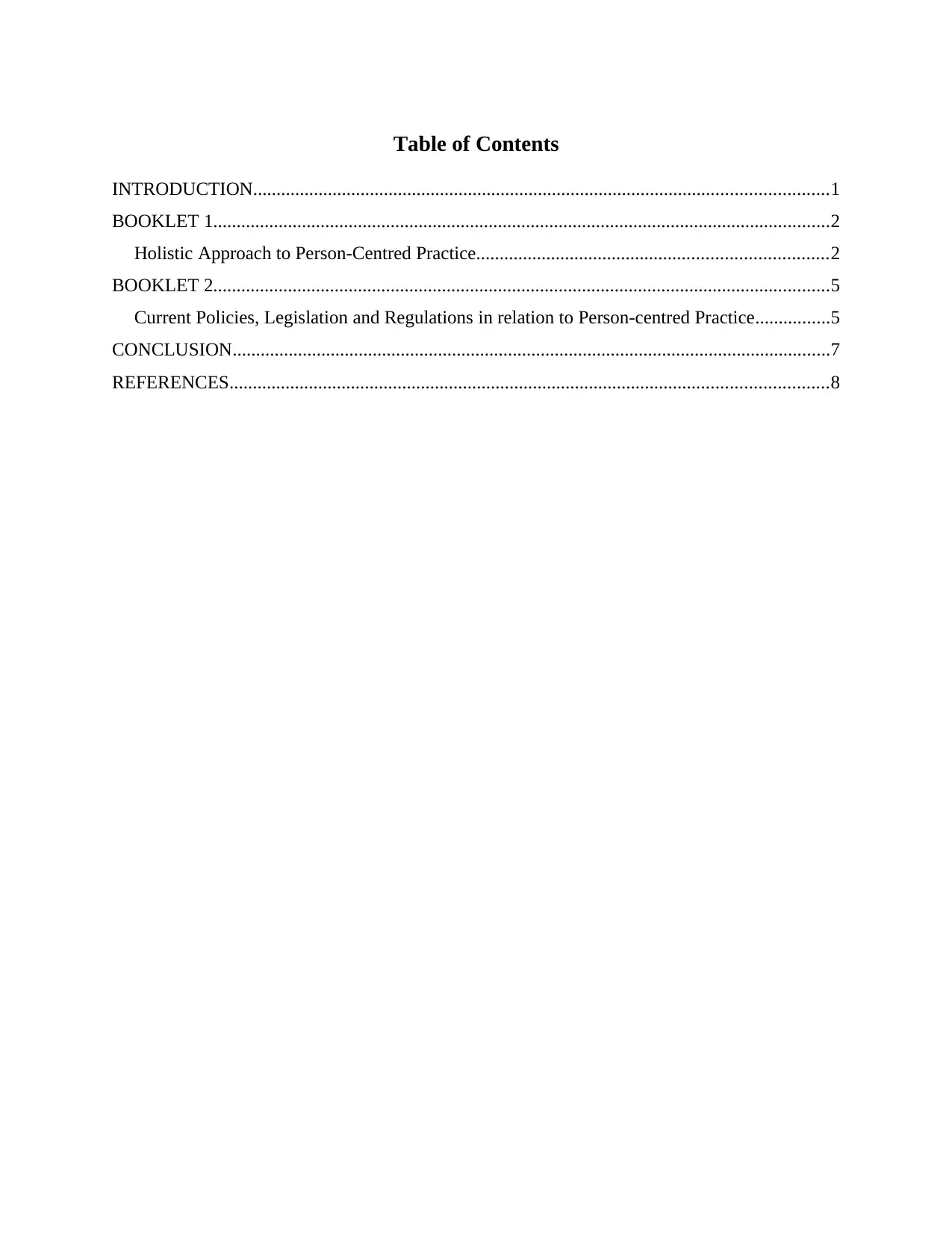
Table of Contents
INTRODUCTION...........................................................................................................................1
BOOKLET 1....................................................................................................................................2
Holistic Approach to Person-Centred Practice...........................................................................2
BOOKLET 2....................................................................................................................................5
Current Policies, Legislation and Regulations in relation to Person-centred Practice................5
CONCLUSION................................................................................................................................7
REFERENCES................................................................................................................................8
INTRODUCTION...........................................................................................................................1
BOOKLET 1....................................................................................................................................2
Holistic Approach to Person-Centred Practice...........................................................................2
BOOKLET 2....................................................................................................................................5
Current Policies, Legislation and Regulations in relation to Person-centred Practice................5
CONCLUSION................................................................................................................................7
REFERENCES................................................................................................................................8
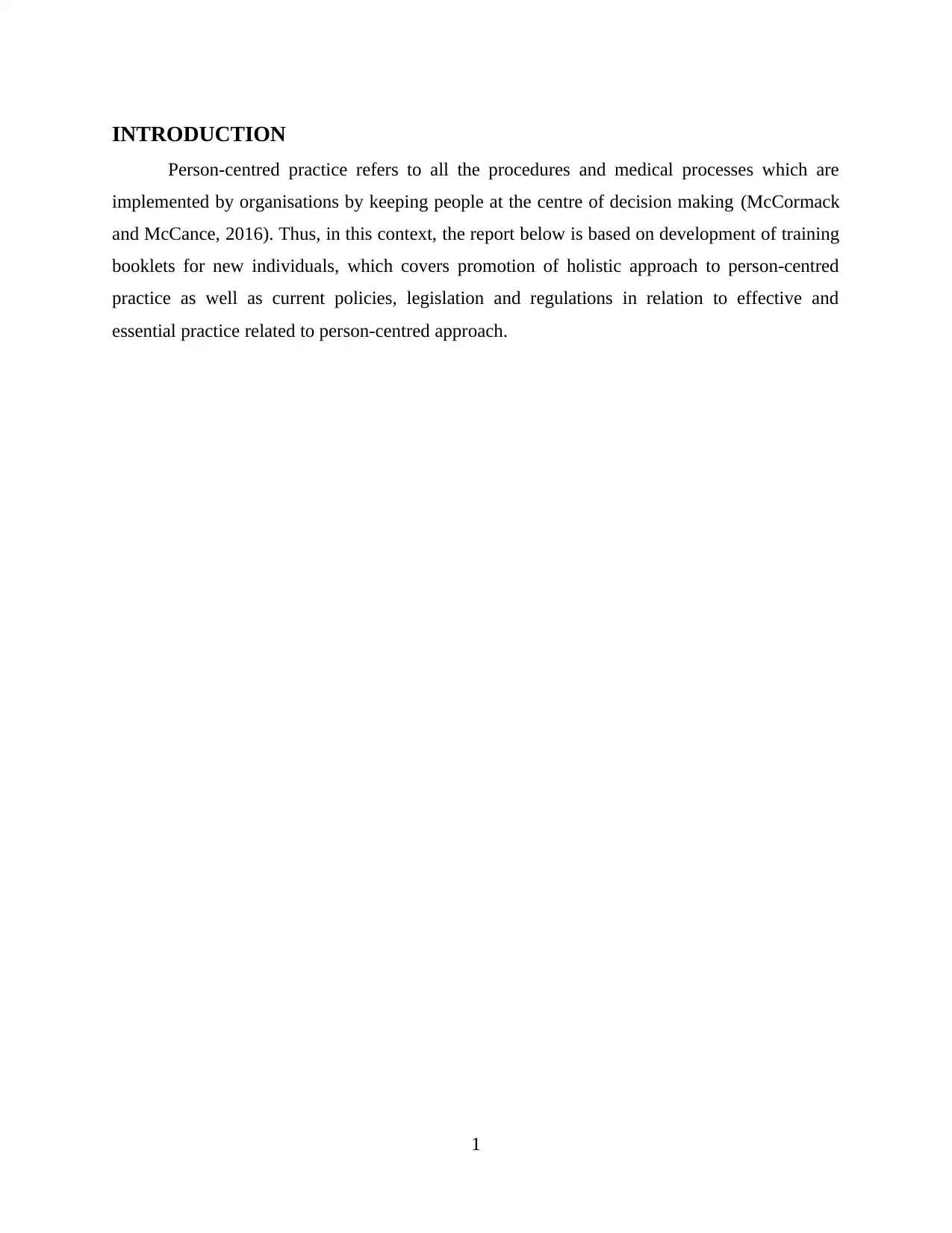
INTRODUCTION
Person-centred practice refers to all the procedures and medical processes which are
implemented by organisations by keeping people at the centre of decision making (McCormack
and McCance, 2016). Thus, in this context, the report below is based on development of training
booklets for new individuals, which covers promotion of holistic approach to person-centred
practice as well as current policies, legislation and regulations in relation to effective and
essential practice related to person-centred approach.
1
Person-centred practice refers to all the procedures and medical processes which are
implemented by organisations by keeping people at the centre of decision making (McCormack
and McCance, 2016). Thus, in this context, the report below is based on development of training
booklets for new individuals, which covers promotion of holistic approach to person-centred
practice as well as current policies, legislation and regulations in relation to effective and
essential practice related to person-centred approach.
1
⊘ This is a preview!⊘
Do you want full access?
Subscribe today to unlock all pages.

Trusted by 1+ million students worldwide
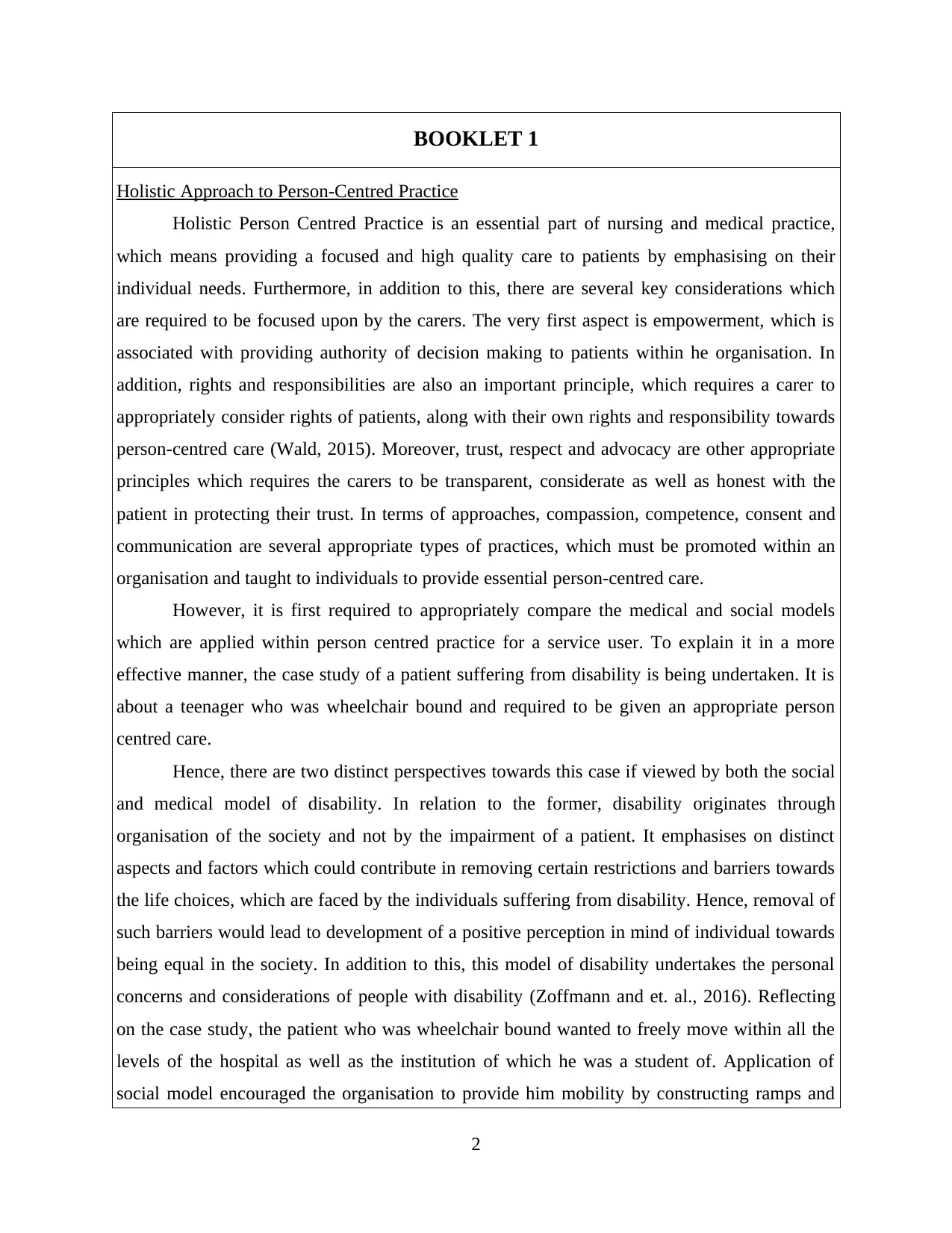
BOOKLET 1
Holistic Approach to Person-Centred Practice
Holistic Person Centred Practice is an essential part of nursing and medical practice,
which means providing a focused and high quality care to patients by emphasising on their
individual needs. Furthermore, in addition to this, there are several key considerations which
are required to be focused upon by the carers. The very first aspect is empowerment, which is
associated with providing authority of decision making to patients within he organisation. In
addition, rights and responsibilities are also an important principle, which requires a carer to
appropriately consider rights of patients, along with their own rights and responsibility towards
person-centred care (Wald, 2015). Moreover, trust, respect and advocacy are other appropriate
principles which requires the carers to be transparent, considerate as well as honest with the
patient in protecting their trust. In terms of approaches, compassion, competence, consent and
communication are several appropriate types of practices, which must be promoted within an
organisation and taught to individuals to provide essential person-centred care.
However, it is first required to appropriately compare the medical and social models
which are applied within person centred practice for a service user. To explain it in a more
effective manner, the case study of a patient suffering from disability is being undertaken. It is
about a teenager who was wheelchair bound and required to be given an appropriate person
centred care.
Hence, there are two distinct perspectives towards this case if viewed by both the social
and medical model of disability. In relation to the former, disability originates through
organisation of the society and not by the impairment of a patient. It emphasises on distinct
aspects and factors which could contribute in removing certain restrictions and barriers towards
the life choices, which are faced by the individuals suffering from disability. Hence, removal of
such barriers would lead to development of a positive perception in mind of individual towards
being equal in the society. In addition to this, this model of disability undertakes the personal
concerns and considerations of people with disability (Zoffmann and et. al., 2016). Reflecting
on the case study, the patient who was wheelchair bound wanted to freely move within all the
levels of the hospital as well as the institution of which he was a student of. Application of
social model encouraged the organisation to provide him mobility by constructing ramps and
2
Holistic Approach to Person-Centred Practice
Holistic Person Centred Practice is an essential part of nursing and medical practice,
which means providing a focused and high quality care to patients by emphasising on their
individual needs. Furthermore, in addition to this, there are several key considerations which
are required to be focused upon by the carers. The very first aspect is empowerment, which is
associated with providing authority of decision making to patients within he organisation. In
addition, rights and responsibilities are also an important principle, which requires a carer to
appropriately consider rights of patients, along with their own rights and responsibility towards
person-centred care (Wald, 2015). Moreover, trust, respect and advocacy are other appropriate
principles which requires the carers to be transparent, considerate as well as honest with the
patient in protecting their trust. In terms of approaches, compassion, competence, consent and
communication are several appropriate types of practices, which must be promoted within an
organisation and taught to individuals to provide essential person-centred care.
However, it is first required to appropriately compare the medical and social models
which are applied within person centred practice for a service user. To explain it in a more
effective manner, the case study of a patient suffering from disability is being undertaken. It is
about a teenager who was wheelchair bound and required to be given an appropriate person
centred care.
Hence, there are two distinct perspectives towards this case if viewed by both the social
and medical model of disability. In relation to the former, disability originates through
organisation of the society and not by the impairment of a patient. It emphasises on distinct
aspects and factors which could contribute in removing certain restrictions and barriers towards
the life choices, which are faced by the individuals suffering from disability. Hence, removal of
such barriers would lead to development of a positive perception in mind of individual towards
being equal in the society. In addition to this, this model of disability undertakes the personal
concerns and considerations of people with disability (Zoffmann and et. al., 2016). Reflecting
on the case study, the patient who was wheelchair bound wanted to freely move within all the
levels of the hospital as well as the institution of which he was a student of. Application of
social model encouraged the organisation to provide him mobility by constructing ramps and
2
Paraphrase This Document
Need a fresh take? Get an instant paraphrase of this document with our AI Paraphraser
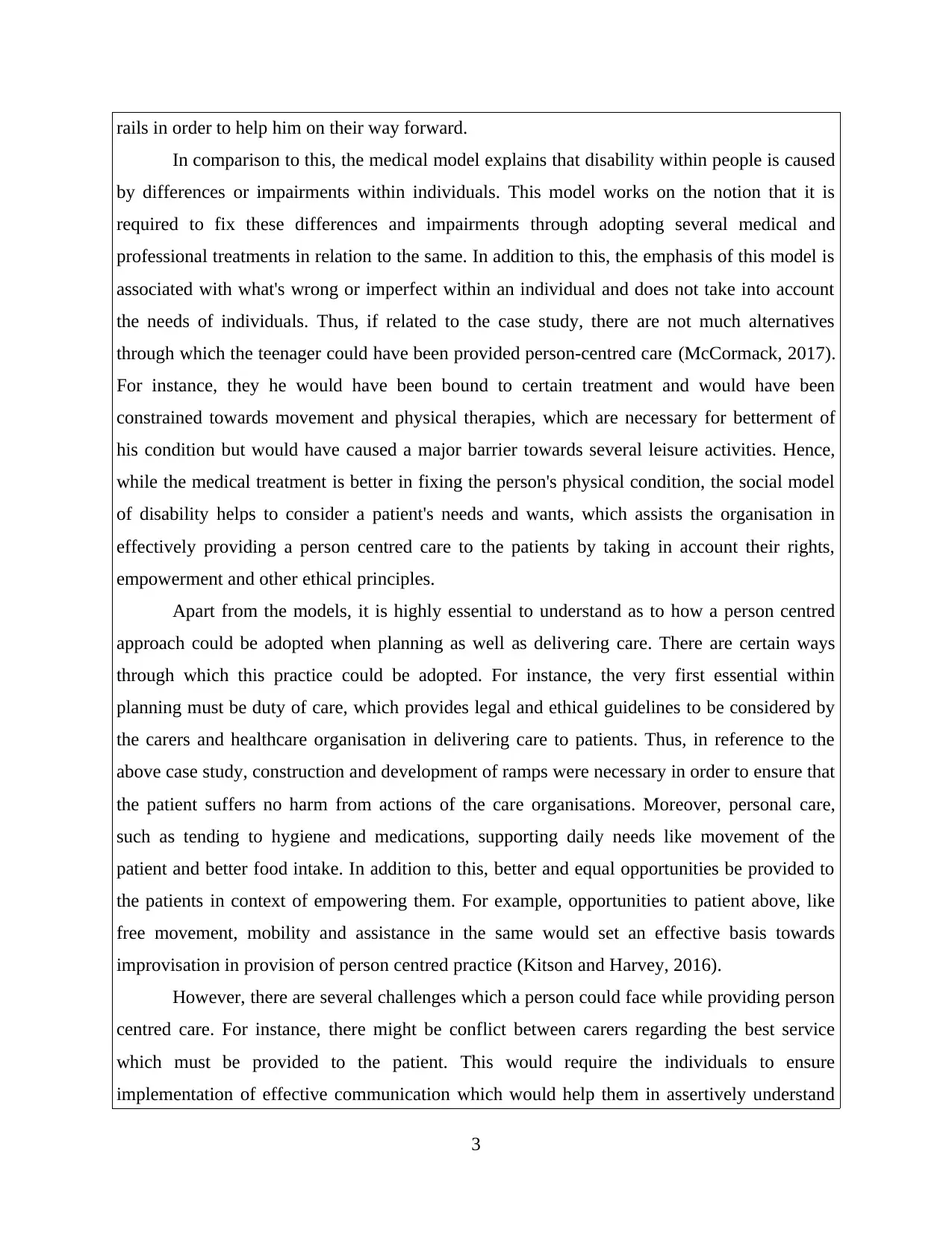
rails in order to help him on their way forward.
In comparison to this, the medical model explains that disability within people is caused
by differences or impairments within individuals. This model works on the notion that it is
required to fix these differences and impairments through adopting several medical and
professional treatments in relation to the same. In addition to this, the emphasis of this model is
associated with what's wrong or imperfect within an individual and does not take into account
the needs of individuals. Thus, if related to the case study, there are not much alternatives
through which the teenager could have been provided person-centred care (McCormack, 2017).
For instance, they he would have been bound to certain treatment and would have been
constrained towards movement and physical therapies, which are necessary for betterment of
his condition but would have caused a major barrier towards several leisure activities. Hence,
while the medical treatment is better in fixing the person's physical condition, the social model
of disability helps to consider a patient's needs and wants, which assists the organisation in
effectively providing a person centred care to the patients by taking in account their rights,
empowerment and other ethical principles.
Apart from the models, it is highly essential to understand as to how a person centred
approach could be adopted when planning as well as delivering care. There are certain ways
through which this practice could be adopted. For instance, the very first essential within
planning must be duty of care, which provides legal and ethical guidelines to be considered by
the carers and healthcare organisation in delivering care to patients. Thus, in reference to the
above case study, construction and development of ramps were necessary in order to ensure that
the patient suffers no harm from actions of the care organisations. Moreover, personal care,
such as tending to hygiene and medications, supporting daily needs like movement of the
patient and better food intake. In addition to this, better and equal opportunities be provided to
the patients in context of empowering them. For example, opportunities to patient above, like
free movement, mobility and assistance in the same would set an effective basis towards
improvisation in provision of person centred practice (Kitson and Harvey, 2016).
However, there are several challenges which a person could face while providing person
centred care. For instance, there might be conflict between carers regarding the best service
which must be provided to the patient. This would require the individuals to ensure
implementation of effective communication which would help them in assertively understand
3
In comparison to this, the medical model explains that disability within people is caused
by differences or impairments within individuals. This model works on the notion that it is
required to fix these differences and impairments through adopting several medical and
professional treatments in relation to the same. In addition to this, the emphasis of this model is
associated with what's wrong or imperfect within an individual and does not take into account
the needs of individuals. Thus, if related to the case study, there are not much alternatives
through which the teenager could have been provided person-centred care (McCormack, 2017).
For instance, they he would have been bound to certain treatment and would have been
constrained towards movement and physical therapies, which are necessary for betterment of
his condition but would have caused a major barrier towards several leisure activities. Hence,
while the medical treatment is better in fixing the person's physical condition, the social model
of disability helps to consider a patient's needs and wants, which assists the organisation in
effectively providing a person centred care to the patients by taking in account their rights,
empowerment and other ethical principles.
Apart from the models, it is highly essential to understand as to how a person centred
approach could be adopted when planning as well as delivering care. There are certain ways
through which this practice could be adopted. For instance, the very first essential within
planning must be duty of care, which provides legal and ethical guidelines to be considered by
the carers and healthcare organisation in delivering care to patients. Thus, in reference to the
above case study, construction and development of ramps were necessary in order to ensure that
the patient suffers no harm from actions of the care organisations. Moreover, personal care,
such as tending to hygiene and medications, supporting daily needs like movement of the
patient and better food intake. In addition to this, better and equal opportunities be provided to
the patients in context of empowering them. For example, opportunities to patient above, like
free movement, mobility and assistance in the same would set an effective basis towards
improvisation in provision of person centred practice (Kitson and Harvey, 2016).
However, there are several challenges which a person could face while providing person
centred care. For instance, there might be conflict between carers regarding the best service
which must be provided to the patient. This would require the individuals to ensure
implementation of effective communication which would help them in assertively understand
3
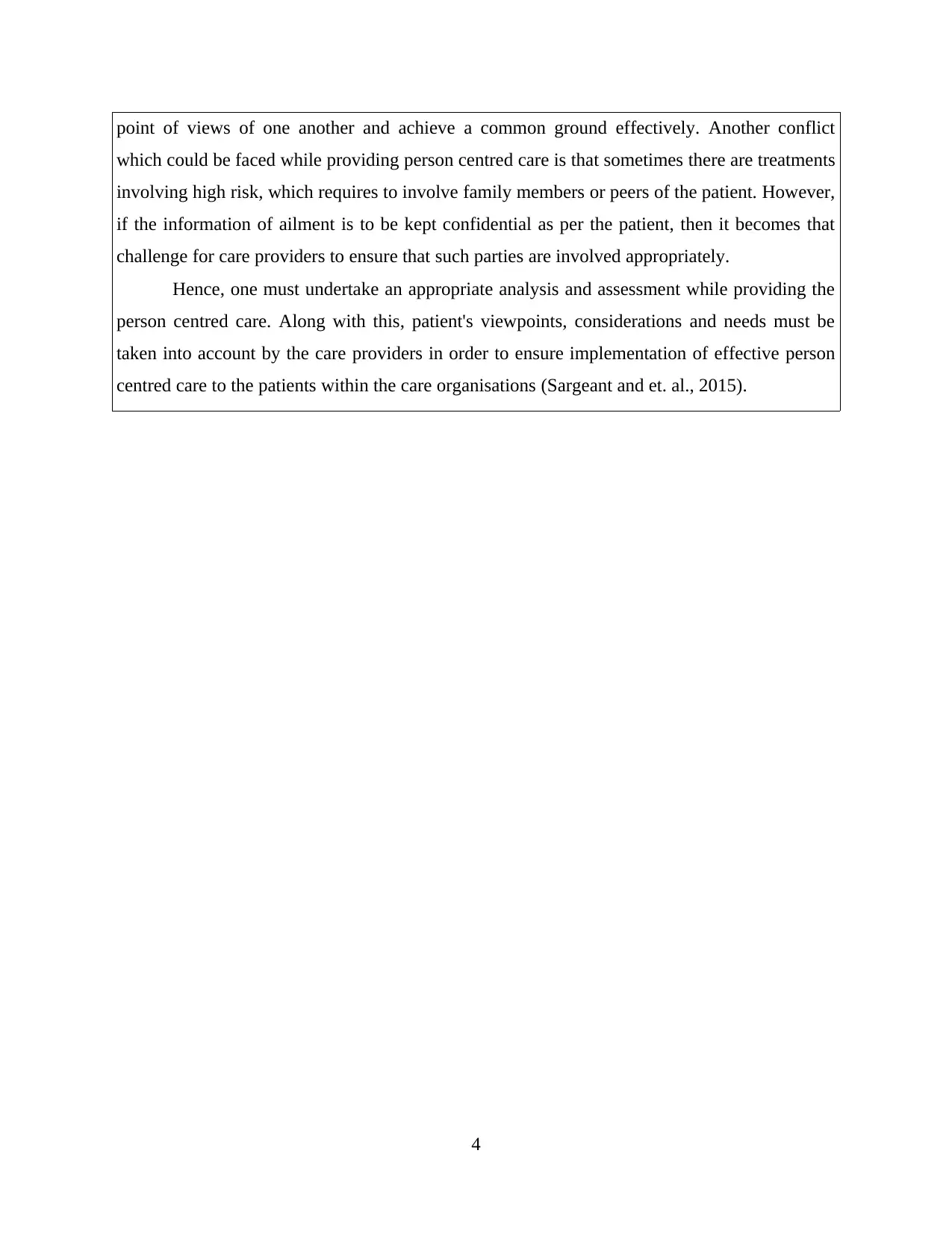
point of views of one another and achieve a common ground effectively. Another conflict
which could be faced while providing person centred care is that sometimes there are treatments
involving high risk, which requires to involve family members or peers of the patient. However,
if the information of ailment is to be kept confidential as per the patient, then it becomes that
challenge for care providers to ensure that such parties are involved appropriately.
Hence, one must undertake an appropriate analysis and assessment while providing the
person centred care. Along with this, patient's viewpoints, considerations and needs must be
taken into account by the care providers in order to ensure implementation of effective person
centred care to the patients within the care organisations (Sargeant and et. al., 2015).
4
which could be faced while providing person centred care is that sometimes there are treatments
involving high risk, which requires to involve family members or peers of the patient. However,
if the information of ailment is to be kept confidential as per the patient, then it becomes that
challenge for care providers to ensure that such parties are involved appropriately.
Hence, one must undertake an appropriate analysis and assessment while providing the
person centred care. Along with this, patient's viewpoints, considerations and needs must be
taken into account by the care providers in order to ensure implementation of effective person
centred care to the patients within the care organisations (Sargeant and et. al., 2015).
4
⊘ This is a preview!⊘
Do you want full access?
Subscribe today to unlock all pages.

Trusted by 1+ million students worldwide
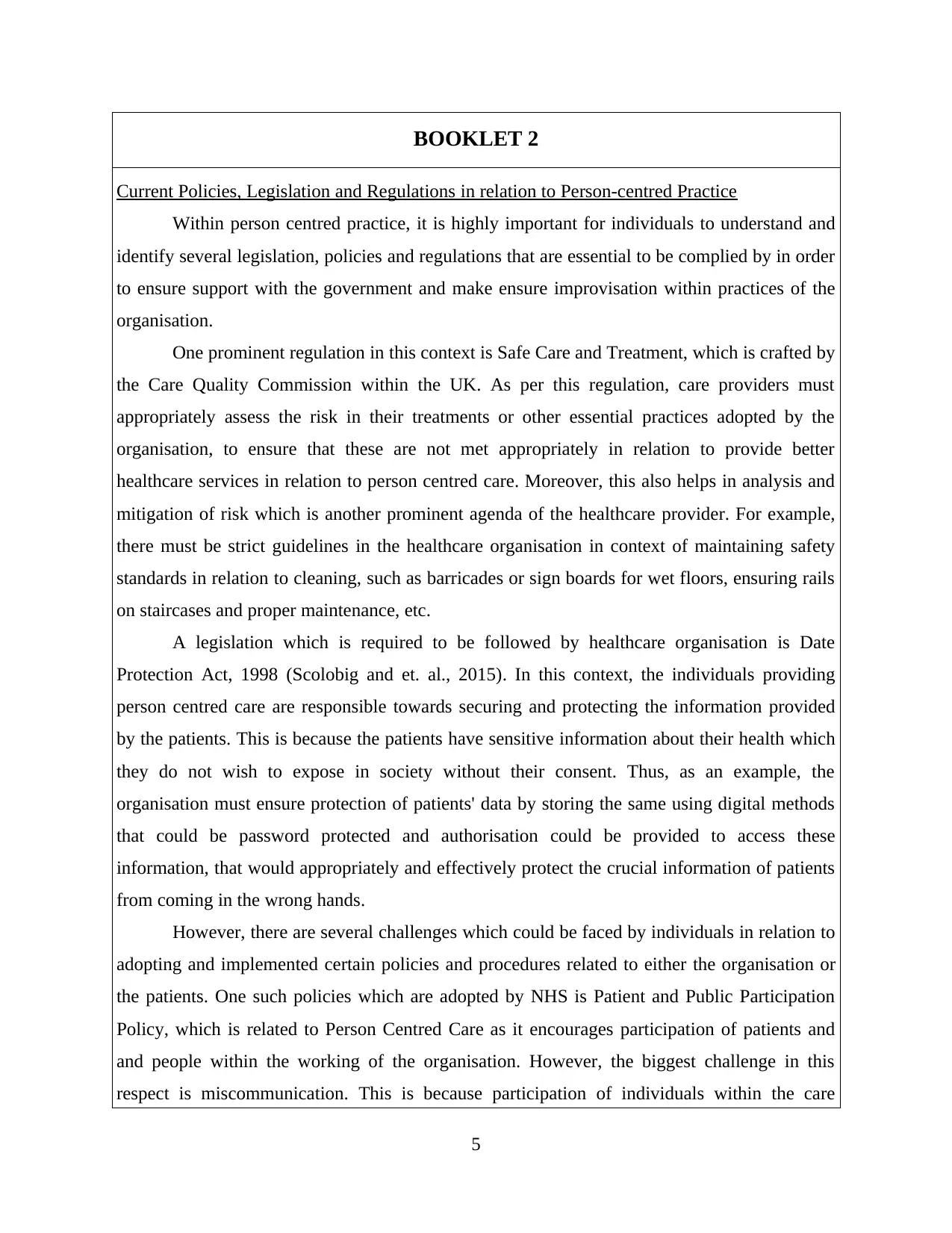
BOOKLET 2
Current Policies, Legislation and Regulations in relation to Person-centred Practice
Within person centred practice, it is highly important for individuals to understand and
identify several legislation, policies and regulations that are essential to be complied by in order
to ensure support with the government and make ensure improvisation within practices of the
organisation.
One prominent regulation in this context is Safe Care and Treatment, which is crafted by
the Care Quality Commission within the UK. As per this regulation, care providers must
appropriately assess the risk in their treatments or other essential practices adopted by the
organisation, to ensure that these are not met appropriately in relation to provide better
healthcare services in relation to person centred care. Moreover, this also helps in analysis and
mitigation of risk which is another prominent agenda of the healthcare provider. For example,
there must be strict guidelines in the healthcare organisation in context of maintaining safety
standards in relation to cleaning, such as barricades or sign boards for wet floors, ensuring rails
on staircases and proper maintenance, etc.
A legislation which is required to be followed by healthcare organisation is Date
Protection Act, 1998 (Scolobig and et. al., 2015). In this context, the individuals providing
person centred care are responsible towards securing and protecting the information provided
by the patients. This is because the patients have sensitive information about their health which
they do not wish to expose in society without their consent. Thus, as an example, the
organisation must ensure protection of patients' data by storing the same using digital methods
that could be password protected and authorisation could be provided to access these
information, that would appropriately and effectively protect the crucial information of patients
from coming in the wrong hands.
However, there are several challenges which could be faced by individuals in relation to
adopting and implemented certain policies and procedures related to either the organisation or
the patients. One such policies which are adopted by NHS is Patient and Public Participation
Policy, which is related to Person Centred Care as it encourages participation of patients and
and people within the working of the organisation. However, the biggest challenge in this
respect is miscommunication. This is because participation of individuals within the care
5
Current Policies, Legislation and Regulations in relation to Person-centred Practice
Within person centred practice, it is highly important for individuals to understand and
identify several legislation, policies and regulations that are essential to be complied by in order
to ensure support with the government and make ensure improvisation within practices of the
organisation.
One prominent regulation in this context is Safe Care and Treatment, which is crafted by
the Care Quality Commission within the UK. As per this regulation, care providers must
appropriately assess the risk in their treatments or other essential practices adopted by the
organisation, to ensure that these are not met appropriately in relation to provide better
healthcare services in relation to person centred care. Moreover, this also helps in analysis and
mitigation of risk which is another prominent agenda of the healthcare provider. For example,
there must be strict guidelines in the healthcare organisation in context of maintaining safety
standards in relation to cleaning, such as barricades or sign boards for wet floors, ensuring rails
on staircases and proper maintenance, etc.
A legislation which is required to be followed by healthcare organisation is Date
Protection Act, 1998 (Scolobig and et. al., 2015). In this context, the individuals providing
person centred care are responsible towards securing and protecting the information provided
by the patients. This is because the patients have sensitive information about their health which
they do not wish to expose in society without their consent. Thus, as an example, the
organisation must ensure protection of patients' data by storing the same using digital methods
that could be password protected and authorisation could be provided to access these
information, that would appropriately and effectively protect the crucial information of patients
from coming in the wrong hands.
However, there are several challenges which could be faced by individuals in relation to
adopting and implemented certain policies and procedures related to either the organisation or
the patients. One such policies which are adopted by NHS is Patient and Public Participation
Policy, which is related to Person Centred Care as it encourages participation of patients and
and people within the working of the organisation. However, the biggest challenge in this
respect is miscommunication. This is because participation of individuals within the care
5
Paraphrase This Document
Need a fresh take? Get an instant paraphrase of this document with our AI Paraphraser
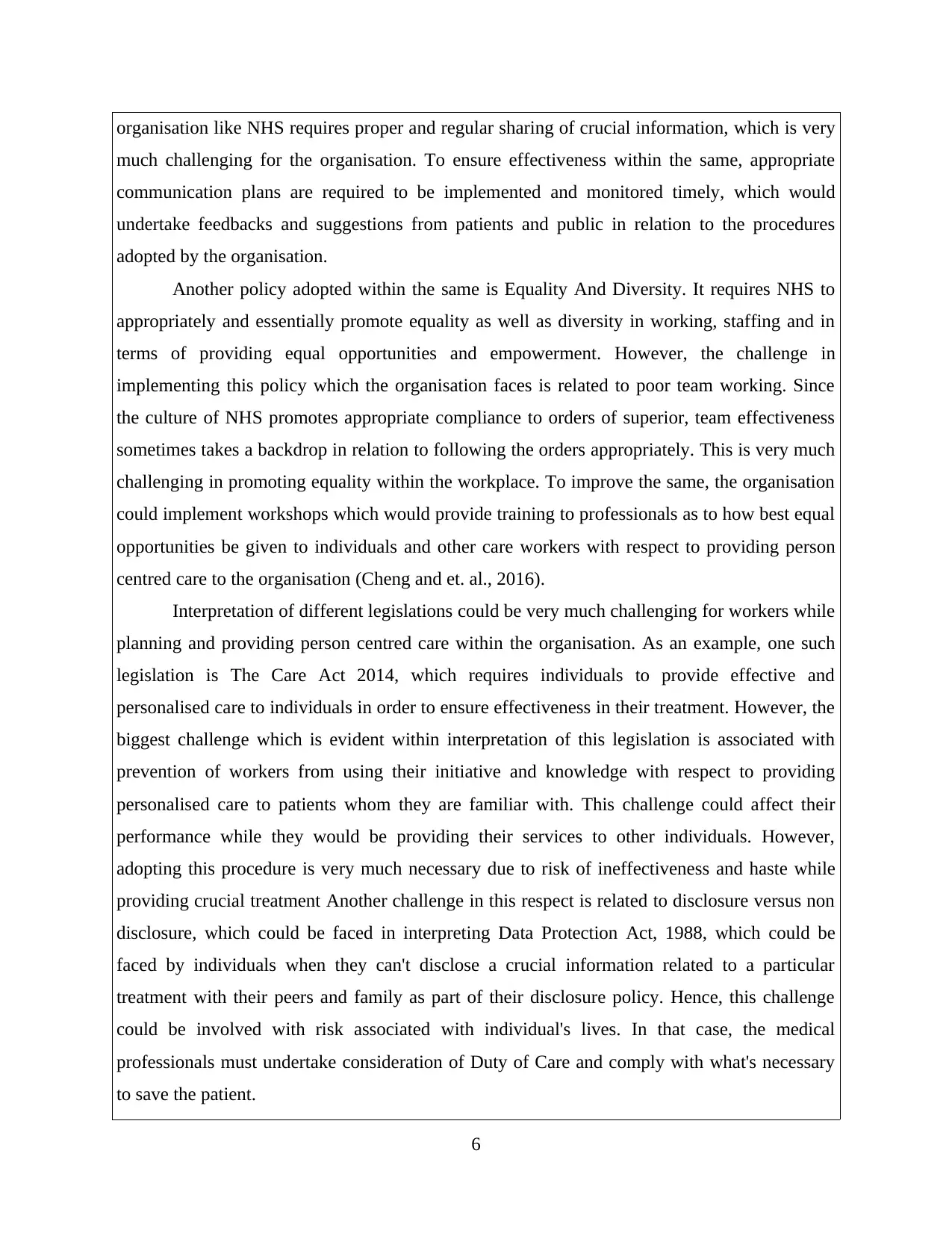
organisation like NHS requires proper and regular sharing of crucial information, which is very
much challenging for the organisation. To ensure effectiveness within the same, appropriate
communication plans are required to be implemented and monitored timely, which would
undertake feedbacks and suggestions from patients and public in relation to the procedures
adopted by the organisation.
Another policy adopted within the same is Equality And Diversity. It requires NHS to
appropriately and essentially promote equality as well as diversity in working, staffing and in
terms of providing equal opportunities and empowerment. However, the challenge in
implementing this policy which the organisation faces is related to poor team working. Since
the culture of NHS promotes appropriate compliance to orders of superior, team effectiveness
sometimes takes a backdrop in relation to following the orders appropriately. This is very much
challenging in promoting equality within the workplace. To improve the same, the organisation
could implement workshops which would provide training to professionals as to how best equal
opportunities be given to individuals and other care workers with respect to providing person
centred care to the organisation (Cheng and et. al., 2016).
Interpretation of different legislations could be very much challenging for workers while
planning and providing person centred care within the organisation. As an example, one such
legislation is The Care Act 2014, which requires individuals to provide effective and
personalised care to individuals in order to ensure effectiveness in their treatment. However, the
biggest challenge which is evident within interpretation of this legislation is associated with
prevention of workers from using their initiative and knowledge with respect to providing
personalised care to patients whom they are familiar with. This challenge could affect their
performance while they would be providing their services to other individuals. However,
adopting this procedure is very much necessary due to risk of ineffectiveness and haste while
providing crucial treatment Another challenge in this respect is related to disclosure versus non
disclosure, which could be faced in interpreting Data Protection Act, 1988, which could be
faced by individuals when they can't disclose a crucial information related to a particular
treatment with their peers and family as part of their disclosure policy. Hence, this challenge
could be involved with risk associated with individual's lives. In that case, the medical
professionals must undertake consideration of Duty of Care and comply with what's necessary
to save the patient.
6
much challenging for the organisation. To ensure effectiveness within the same, appropriate
communication plans are required to be implemented and monitored timely, which would
undertake feedbacks and suggestions from patients and public in relation to the procedures
adopted by the organisation.
Another policy adopted within the same is Equality And Diversity. It requires NHS to
appropriately and essentially promote equality as well as diversity in working, staffing and in
terms of providing equal opportunities and empowerment. However, the challenge in
implementing this policy which the organisation faces is related to poor team working. Since
the culture of NHS promotes appropriate compliance to orders of superior, team effectiveness
sometimes takes a backdrop in relation to following the orders appropriately. This is very much
challenging in promoting equality within the workplace. To improve the same, the organisation
could implement workshops which would provide training to professionals as to how best equal
opportunities be given to individuals and other care workers with respect to providing person
centred care to the organisation (Cheng and et. al., 2016).
Interpretation of different legislations could be very much challenging for workers while
planning and providing person centred care within the organisation. As an example, one such
legislation is The Care Act 2014, which requires individuals to provide effective and
personalised care to individuals in order to ensure effectiveness in their treatment. However, the
biggest challenge which is evident within interpretation of this legislation is associated with
prevention of workers from using their initiative and knowledge with respect to providing
personalised care to patients whom they are familiar with. This challenge could affect their
performance while they would be providing their services to other individuals. However,
adopting this procedure is very much necessary due to risk of ineffectiveness and haste while
providing crucial treatment Another challenge in this respect is related to disclosure versus non
disclosure, which could be faced in interpreting Data Protection Act, 1988, which could be
faced by individuals when they can't disclose a crucial information related to a particular
treatment with their peers and family as part of their disclosure policy. Hence, this challenge
could be involved with risk associated with individual's lives. In that case, the medical
professionals must undertake consideration of Duty of Care and comply with what's necessary
to save the patient.
6
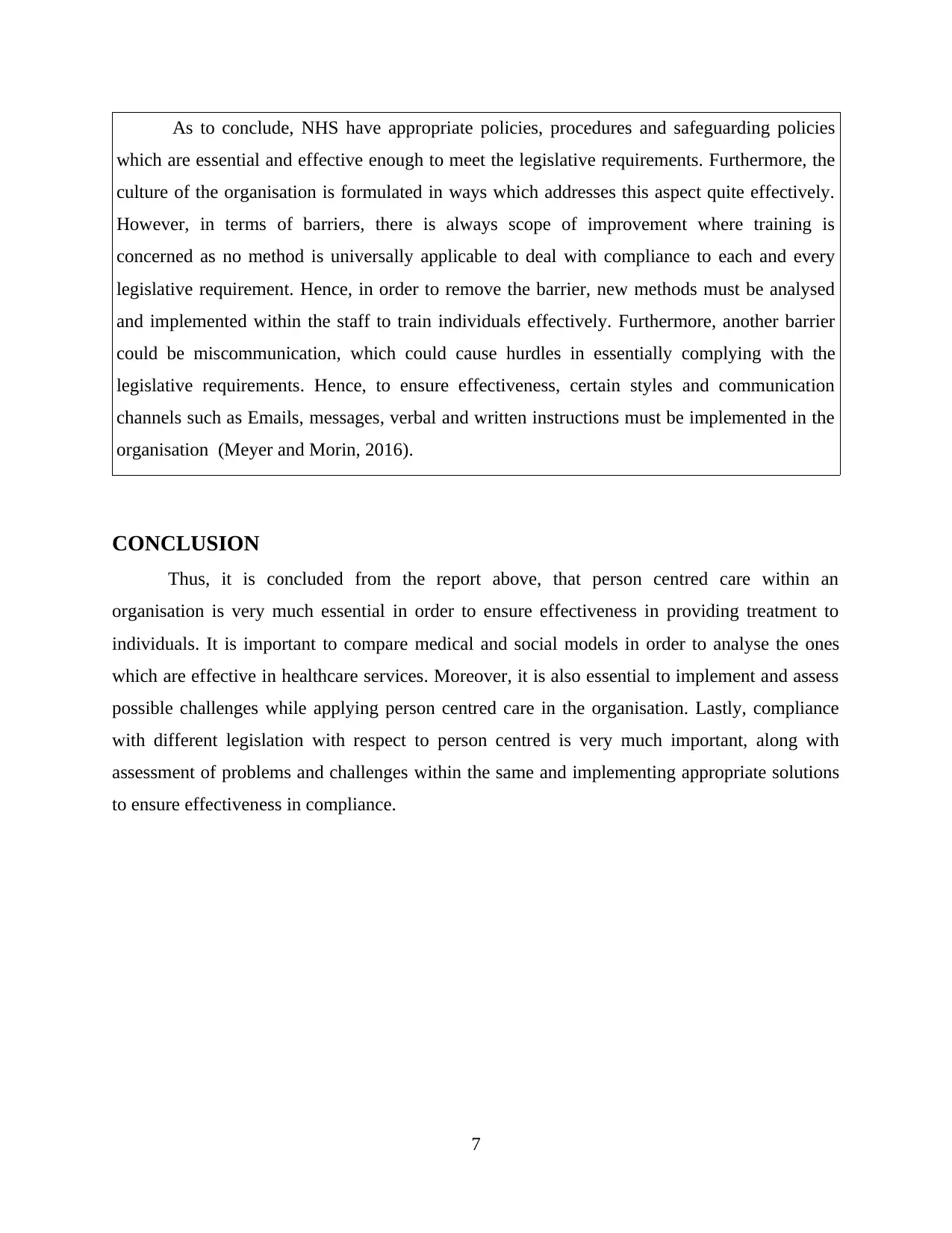
As to conclude, NHS have appropriate policies, procedures and safeguarding policies
which are essential and effective enough to meet the legislative requirements. Furthermore, the
culture of the organisation is formulated in ways which addresses this aspect quite effectively.
However, in terms of barriers, there is always scope of improvement where training is
concerned as no method is universally applicable to deal with compliance to each and every
legislative requirement. Hence, in order to remove the barrier, new methods must be analysed
and implemented within the staff to train individuals effectively. Furthermore, another barrier
could be miscommunication, which could cause hurdles in essentially complying with the
legislative requirements. Hence, to ensure effectiveness, certain styles and communication
channels such as Emails, messages, verbal and written instructions must be implemented in the
organisation (Meyer and Morin, 2016).
CONCLUSION
Thus, it is concluded from the report above, that person centred care within an
organisation is very much essential in order to ensure effectiveness in providing treatment to
individuals. It is important to compare medical and social models in order to analyse the ones
which are effective in healthcare services. Moreover, it is also essential to implement and assess
possible challenges while applying person centred care in the organisation. Lastly, compliance
with different legislation with respect to person centred is very much important, along with
assessment of problems and challenges within the same and implementing appropriate solutions
to ensure effectiveness in compliance.
7
which are essential and effective enough to meet the legislative requirements. Furthermore, the
culture of the organisation is formulated in ways which addresses this aspect quite effectively.
However, in terms of barriers, there is always scope of improvement where training is
concerned as no method is universally applicable to deal with compliance to each and every
legislative requirement. Hence, in order to remove the barrier, new methods must be analysed
and implemented within the staff to train individuals effectively. Furthermore, another barrier
could be miscommunication, which could cause hurdles in essentially complying with the
legislative requirements. Hence, to ensure effectiveness, certain styles and communication
channels such as Emails, messages, verbal and written instructions must be implemented in the
organisation (Meyer and Morin, 2016).
CONCLUSION
Thus, it is concluded from the report above, that person centred care within an
organisation is very much essential in order to ensure effectiveness in providing treatment to
individuals. It is important to compare medical and social models in order to analyse the ones
which are effective in healthcare services. Moreover, it is also essential to implement and assess
possible challenges while applying person centred care in the organisation. Lastly, compliance
with different legislation with respect to person centred is very much important, along with
assessment of problems and challenges within the same and implementing appropriate solutions
to ensure effectiveness in compliance.
7
⊘ This is a preview!⊘
Do you want full access?
Subscribe today to unlock all pages.

Trusted by 1+ million students worldwide
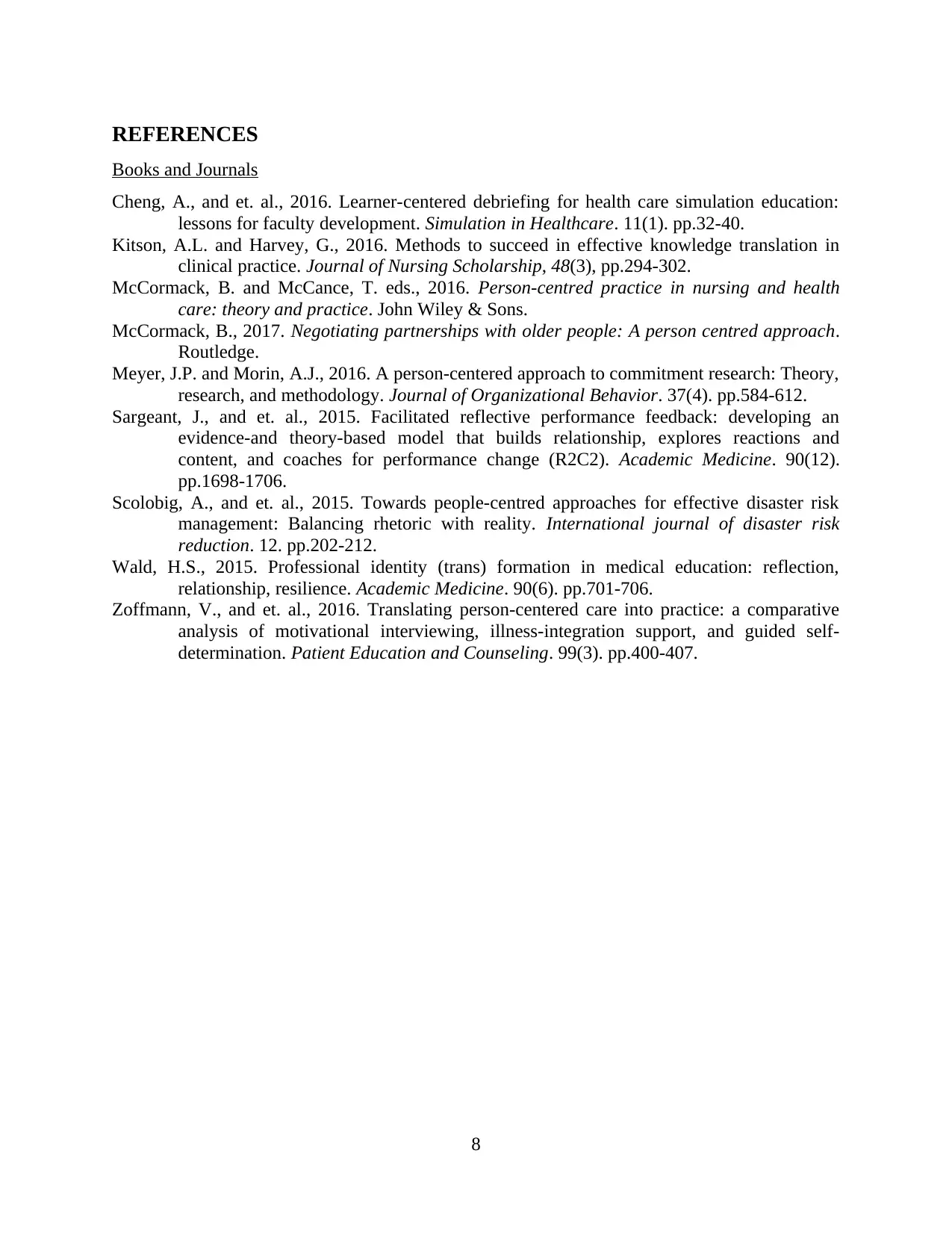
REFERENCES
Books and Journals
Cheng, A., and et. al., 2016. Learner-centered debriefing for health care simulation education:
lessons for faculty development. Simulation in Healthcare. 11(1). pp.32-40.
Kitson, A.L. and Harvey, G., 2016. Methods to succeed in effective knowledge translation in
clinical practice. Journal of Nursing Scholarship, 48(3), pp.294-302.
McCormack, B. and McCance, T. eds., 2016. Person-centred practice in nursing and health
care: theory and practice. John Wiley & Sons.
McCormack, B., 2017. Negotiating partnerships with older people: A person centred approach.
Routledge.
Meyer, J.P. and Morin, A.J., 2016. A person‐centered approach to commitment research: Theory,
research, and methodology. Journal of Organizational Behavior. 37(4). pp.584-612.
Sargeant, J., and et. al., 2015. Facilitated reflective performance feedback: developing an
evidence-and theory-based model that builds relationship, explores reactions and
content, and coaches for performance change (R2C2). Academic Medicine. 90(12).
pp.1698-1706.
Scolobig, A., and et. al., 2015. Towards people-centred approaches for effective disaster risk
management: Balancing rhetoric with reality. International journal of disaster risk
reduction. 12. pp.202-212.
Wald, H.S., 2015. Professional identity (trans) formation in medical education: reflection,
relationship, resilience. Academic Medicine. 90(6). pp.701-706.
Zoffmann, V., and et. al., 2016. Translating person-centered care into practice: a comparative
analysis of motivational interviewing, illness-integration support, and guided self-
determination. Patient Education and Counseling. 99(3). pp.400-407.
8
Books and Journals
Cheng, A., and et. al., 2016. Learner-centered debriefing for health care simulation education:
lessons for faculty development. Simulation in Healthcare. 11(1). pp.32-40.
Kitson, A.L. and Harvey, G., 2016. Methods to succeed in effective knowledge translation in
clinical practice. Journal of Nursing Scholarship, 48(3), pp.294-302.
McCormack, B. and McCance, T. eds., 2016. Person-centred practice in nursing and health
care: theory and practice. John Wiley & Sons.
McCormack, B., 2017. Negotiating partnerships with older people: A person centred approach.
Routledge.
Meyer, J.P. and Morin, A.J., 2016. A person‐centered approach to commitment research: Theory,
research, and methodology. Journal of Organizational Behavior. 37(4). pp.584-612.
Sargeant, J., and et. al., 2015. Facilitated reflective performance feedback: developing an
evidence-and theory-based model that builds relationship, explores reactions and
content, and coaches for performance change (R2C2). Academic Medicine. 90(12).
pp.1698-1706.
Scolobig, A., and et. al., 2015. Towards people-centred approaches for effective disaster risk
management: Balancing rhetoric with reality. International journal of disaster risk
reduction. 12. pp.202-212.
Wald, H.S., 2015. Professional identity (trans) formation in medical education: reflection,
relationship, resilience. Academic Medicine. 90(6). pp.701-706.
Zoffmann, V., and et. al., 2016. Translating person-centered care into practice: a comparative
analysis of motivational interviewing, illness-integration support, and guided self-
determination. Patient Education and Counseling. 99(3). pp.400-407.
8
1 out of 10
Related Documents
Your All-in-One AI-Powered Toolkit for Academic Success.
+13062052269
info@desklib.com
Available 24*7 on WhatsApp / Email
![[object Object]](/_next/static/media/star-bottom.7253800d.svg)
Unlock your academic potential
Copyright © 2020–2025 A2Z Services. All Rights Reserved. Developed and managed by ZUCOL.





